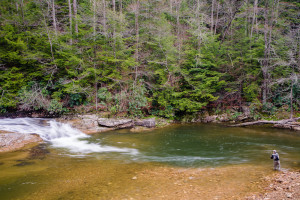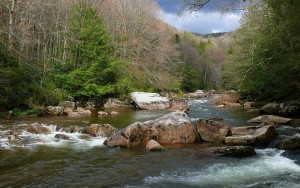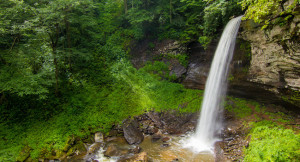By David Lillard

The Cherry River. © Kent Mason
Summer’s approach brings dreams of getting away. For many busy executives in West Virginia, those dreams feel more like fantasy. Following a trend for overloaded managers and business owners, West Virginia’s business execs have a hard time finding an entire week off. And when they do, there’s the constant need—real or imagined—to continuously check email or phone messages.
Maybe it’s time to start a new trend that makes your time away truly a getaway. Take this tip from West Virginia Rivers Coalition, a group dedicated to restoring the state’s exceptional streams: Visit the special places right here in West Virginia, like the southern Monongahela National Forest. And if you can’t imagine disconnecting for a week, how about taking it a couple days at a time?
“The southern Monongahela National Forest has some of the most beautiful scenery in the Appalachians,” says Executive Director Angie Rosser. “It’s also the headwaters of six incredible rivers.”
It’s true; the Cranberry, Cherry, Gauley, Williams, Elk, and Greenbrier rivers all get started within the area. Chances are, if you’re a hunter or an angler, you know how special it is. You don’t have to be particularly outdoor-oriented to enjoy time there. Ride a bike, gaze at waterfalls, have a picnic, take a scenic drive. You can also find plenty of quiet places to paddle a canoe.

The Williams River
“It’s a special place, uniquely West Virginia,” says Rosser. “It’s a real source of pride for our state to have such a wonder.”
Rosser’s group is working with sportsmen and other recreation groups on a plan to keep it that way by having Congress recognize the area as the Birthplace of Rivers National Monument. The designation, proponents say, is a way to preserve those traditional uses—timbering as well as hunting.
“When you think of how many West Virginians grew up fishing there, and come back now with their own children—to see the smiles on those kids–that tells what you need to know,” says Rosser.
There really is something for everyone who loves a little time in the mountains where the cell phone won’t ring. Here are a few highlights:
Cranberry Glades
The mossy Cranberry Glades Botanical Area is the largest area of bogs in West Virginia. Remnants of the last ice age, the bogs are now the southernmost point in North America where some of the flora and fauna found there survive and flourish. “Beyond the ecological history,” says Rosser, “it’s just plain beautiful.” You can walk the glades along an accessible boardwalk.
Falls of Hills Creek

Falls of Hill Creek. © Samuel Taylor Photography
The iconic waterfall of West Virginia, the state’s second highest, is accessible by stairs—steep ones! Hills Creek is considered one of the most pristine waterways in all of West Virginia. The view of the falls has been attracting visitors since the area was first settled.
Tea Creek
Other Mountain State bicycling trails get more media, but they have nothing on the Tea Creek Backcountry. The paths follow early railroad grades under a mixed hardwood forest interspersed with red spruce, pine and a scattered understory of rhododendron. For heartier cyclists, there are also challenging trails.
On the Rocks
Honeycomb Rocks are an example of quartz boxwork, where two geologic processes—rock bending and folding during the mountain-building epoch—clash to create striking patterns in the boulders. See these amazing rocks after a short walk along the Honeycombs Rock Trail.
A Road with a View
The Highland Scenic Highway tops out above 4,500 feet, with views stretching for miles. There are several parking areas along the way where you can pull off, have a picnic and enjoy the view. Print a map, or pick up one at the Cranberry Mountain Nature Center.
The area is accessed from Pocahontas County via Marlinton, and from Richwood in Nicholas County. And if camping isn’t your thing, or if you truly can’t get through the night without having mobile phone coverage, there are options for lodging—and coverage—in both.
For information on Birthplace of Rivers National Monument, visit www.wvrivers.org. For information on places to stay and things to do outside the forest, contact the Pocahontas County CVB or the Summersville CVB.
About the Author
 David Lillard is editor of the Observer monthly in Jefferson County, WV, and frequently writes pieces supporting the West Virginia Rivers Coalition.
David Lillard is editor of the Observer monthly in Jefferson County, WV, and frequently writes pieces supporting the West Virginia Rivers Coalition.



